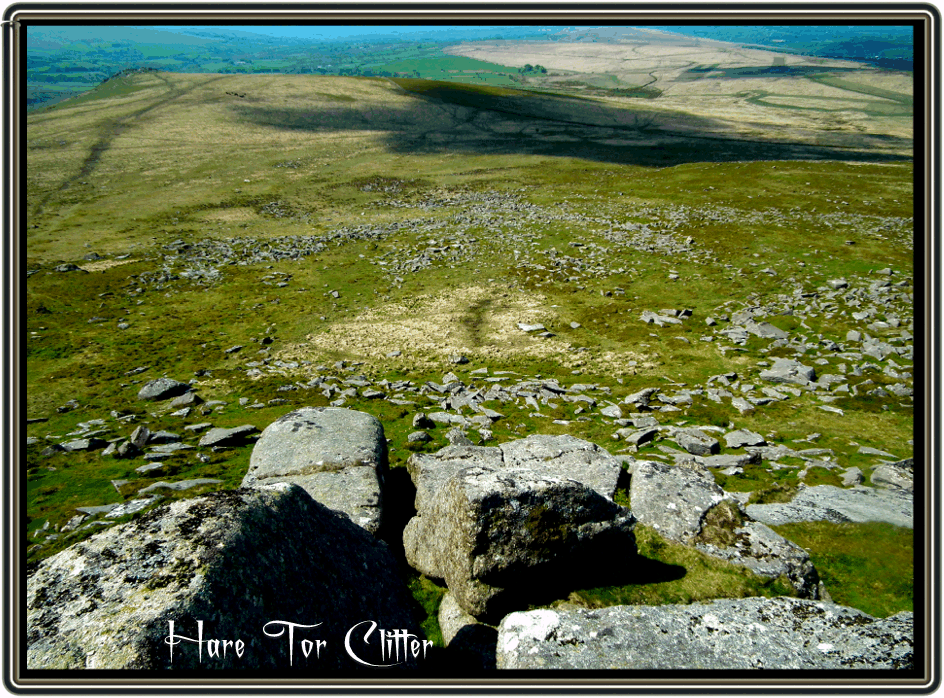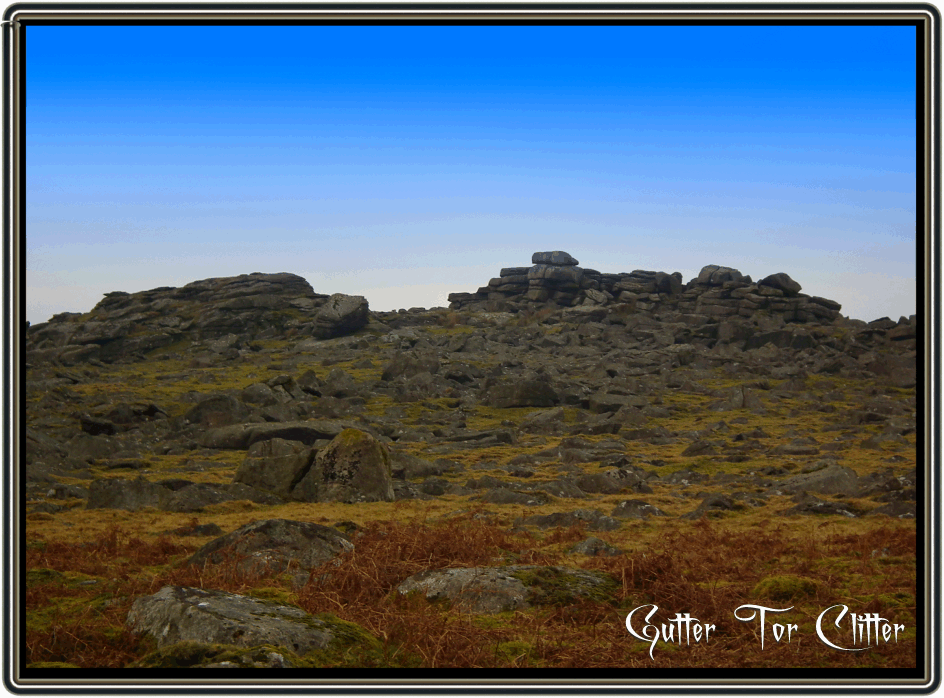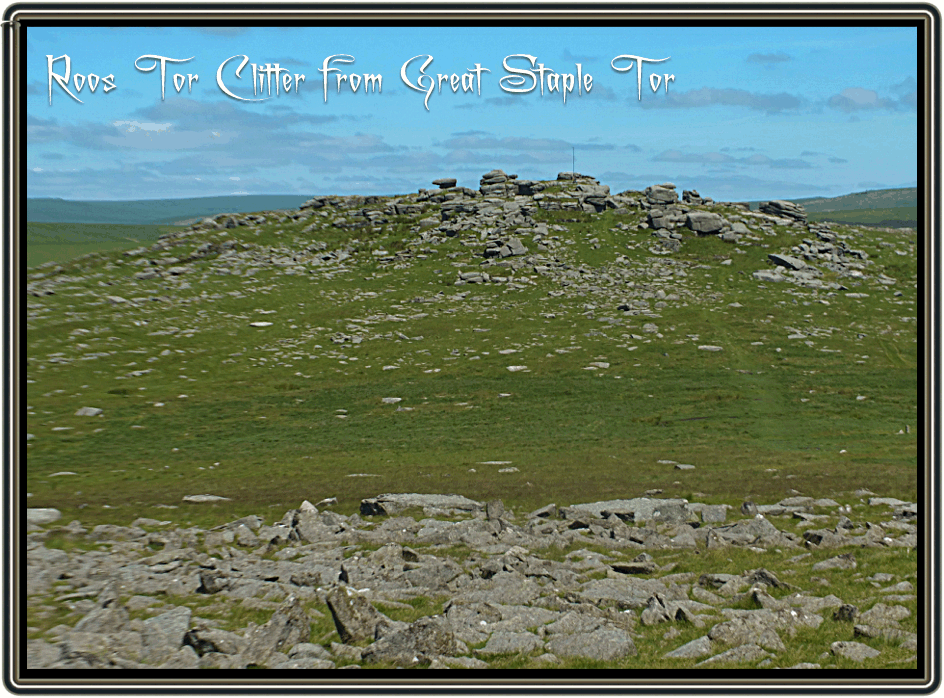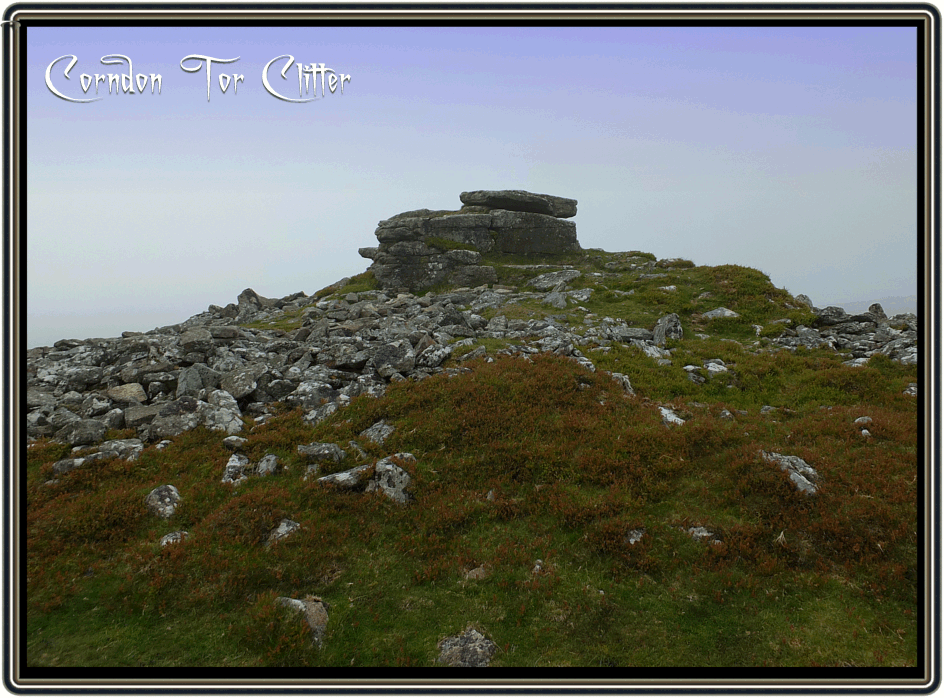
“Down the slopes are scattered in wild confusion huge blocks of splintered granite, locally known as ‘clatters’ or ‘clitters.’ Some of these blocks must weigh scores of tons, and the eye is bewildered by their picturesque disorder and varied forms. Frequently the loveliest ferns fill the interstices, and lichens, grey, white and orange, contrast with the almost black patches of moss, which watered plenteously by the mists, cling to their rugged sides.” J. Ll. W. Page, p.4.
Clitter or Clatter either name, it don’t matter. Beneath many of Dartmoor’s tors lies a clitter, sometimes called a clatter and they present a landscape feature and habitat of their own. Personally speaking they are one of the most unpleasant things to walk through and an accident just waiting to happen. Anybody who has searched for a letterbox in one will know the perils of the hidden ‘caves’, the vegetation covered holes and the unstable rocks – all ankle turners. It has been said that the name ‘clitter’ derives from the old Celtic word clegyr which means rock which is quite apt considering the amount of rocks in a clitter. William Crossing describes such features as being a; “collection of boulders frequently seen covering a considerable area on the side of a hill. These rock-fields are really the ruins of tors.” p.15. Eric Hemery is slightly more forthcoming when he notes that a clitter is a; “Scattered rockfield below a tor, the result of disintegration. This consists in most cases of a dense mass, in others of radiating rock streams.” p.33. In 1871 Bate wrote the following; “Around the base of most of the huge tors that give a mountainous character to Dartmoor cluster large masses of granite rocks in wonderful confusion.” It was his opinion the clitters had been formed by frost action and that upper hillslopes were once coated with perennial layers of ice. This layer of ice allowed the rocks to ‘slide’ down the slope to their final resting places. In 1876 a man called Belt had another theory, he suggested that the rocks which today form the clitters had been glacially transported downhill and then deposited when the ice melted. A few years later in 1865 Mr. Whitely suggested that the clitters were formed when a mighty ‘post glacial flood’ swept the rocks and boulders away from their parent tors. Yet another theory as to the formation of clitters came from Mr. Albers in 1930 who postulated that the rocks had been moved by the action of solifluction. The granite rocks amidst a layer of sediment slid downslope over a layer of permafrost until finally coming to rest in the ‘wonderful confusion’ we see today. Cambell et. al. p.77.
Although there are numerous clitters which sprawl over the Dartmoor Landscape very few have their names surviving today. I have managed to find nine clitter or clatters with actual names and out of those only two, Curtery Clitters and Hawthorn Clitter are actually named on the 1:25,000 Ordnance Survey map. They are; Curtery Clitters (SX593 898), Dean Clatters (SX711 649), Hawthorn Clitter (SX 633 862), Higher Woolholes Clitter (SX68? 64?), Waterfoot Clatters (SX680 655), Wider brook Clitter (SX660 655), Wild Tor Clitter (SX627 876), Withy Tree Clitter (SX620 772) and Woolholes Clitter (SX682 638). Doubtless there were numerous other clitters or clatters whose names have been lost in the dense mists of time.
As can be gathered from Page’s comments above clitters provide a unique habitat for many plants and animals. Along with the mosses, ferns and lichens can often be found clumps of whortleberries which at one time were popular spots for the moorfolk to pick the fruit. Clitters also provide safe harbours for foxes and although the actual word clitter does not appear in the place-name there are clitter locations whose names reflects this fact. Just below Crow Tor is an area of clitter called Foxholes which by its very name suggests this was where foxes frequented. William Crossing writes; “through a clatter, known as Foxholes,” Other such examples are the ‘Foxes Holt’ which is just south of the Ladybrook (according to Hemery this is not on the north east side of Cosdon as marked on OS maps). Similarly there is the ‘Foxes Yard’ which sits in Lustleigh Cleave just below Harton Chest. If you read many of the old local newspaper hunting reports they often say how ‘Old Charlie’ managed to escape the hounds by darting into clitters. One such report from 1926 reads; “The hounds ran up the steep slope of Yar Tor and put their fox into a clitter near its summit. They then took a line away over the road towards Corndon Tor (see photo above), but, keeping left-handed climbed on to North Tor and checked. A view in the valley, however, put them good terms, and they ran hard down the Wallabrook and above Sherril Holts, only to be cheated after an enjoyable 25 minutes by this fox going into the same clitter. The terrier was unable to make any impression, and, being late, there was nothing to do but turn homewards.” – The Western Morning News and Mercury, February 9th, 1926. Once again we have ‘Sherril Holt’s which again could well indicate an area of clitter frequented by foxes, especially in light of this report. Just as foxes can be found in areas of clitter so too can rabbits who similarly get safe refuge from predators amongst the small rock caves. Back in the days when the Dartmoor’s rabbit warrens were being worked the warreners would make use of the clitters. Page related one example from Trowlesworthy Warren; “There are myriads of rabbits disporting themselves among the blocks which plentifully bestrew the slopes (of Trowlesworthy Tor). They are under the care of the warrener, a sturdy old fellow, almost as broad as long…” p.274.
The other aspect of clitters is that of the granite rocks and blocks themselves as they provided a ready source of stone for both industrial use and for general purposes. As there was by far a greater supply of granite as opposed to natural wood many everyday items were fashioned from it. Therefore the stone cutters would look to the various clitters to supply their raw material which in many cases meant working out among the rocks as they cut and fashioned their items. Today there are numerous abandoned artefacts left scattered around the various clitters, some finished others partly finished. Probably there was no more of an iconic industry as that of the Sett Makers who plied their trade amongst many of the clitters on the tors around the central western area of Dartmoor.

Cambell, S., A. J. Gerrard., & C. P. Green. 1998. Granite Landform & Weathering Products. London: Chapman & Hall.
Crossing, W. 1990. Crossing’s Guide to Dartmoor. Newton Abbot: Peninsula Press.
Hemery, E. 1983. High Dartmoor. London: Robert Hale.
Page, J. Ll. W. 1895. An Exploration of Dartmoor. London: Seeley & Co. Ltd.
 Legendary Dartmoor The many aspects past and present of Dartmoor
Legendary Dartmoor The many aspects past and present of Dartmoor




